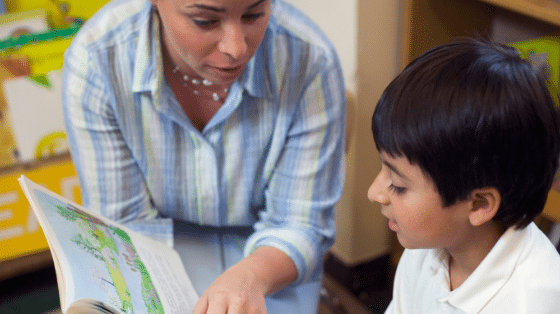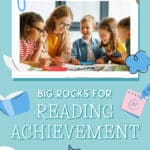
What are your big rocks for reading instruction?
Let me share an oldie but goodie, the “Rock, Pebbles, and Sand” story.
Imagine a jar filled with rocks, sand, and pebbles. The big stones take up most of the space and the cracks in between are filled with small pebbles and grains of sand. The jar is full.
But what would happen if you put the sand and the pebbles into the jar first?
There would be no room for the big rocks!
So, what is the meaning behind this time management analogy?
The big rocks symbolize the most important things in your everyday life or, in this case, reading instruction. The pebbles are other things that matter but hold slightly less importance, and the sand represents all the “small stuff.”
The “Rock, Pebbles and Sand” analogy can be applied to our reading instruction time. The “small stuff” is still important, but if you spend all of your time on them, you’ll run out of time for the core things that will accelerate your students reading achievement.
So again, I ask…What are your big rocks for reading instruction?
I’ve got two big rocks that I consider as non-negotiable activities for reading achievement. I’ve come to this conclusion based on research and my experience as a teacher.
{To watch an edited video where I explain my 2 big rocks for reading achievement hit play below or read on instead. OR, the original, unedited Facebook live video is at the bottom of this post.}
The Two BIGGEST Rocks for Reading Achievement
My two big rocks for reading achievement are…
- Teacher Read Aloud
- Student Read Aloud
When we set up our lessons, we must be laser-focused on these two things.
Why?
Because reading has two basic components: Decoding and Comprehension.
According to the “Simple View of Reading” theory, there’s a simple formula for attaining reading achievement:
Reading Achievement = Decoding x Listening Comprehension
The formula has been supported by many research studies (e.g., this or this). It hints at the importance of Teacher Read Aloud and Student Read Aloud.
With these two activities, we’re able to accelerate reading achievement because they target 1) sound-based decoding and word identification as well as 2) listening comprehension, which are vital for becoming a mature reader.
Strategic guided oral reading practice by the student with feedback from the teacher is one of the best ways to help her develop sound-based decoding, word identification, and fluency.
The teacher read aloud, on the other hand, is one of the best ways to develop oral language abilities, background knowledge, and vocabulary.
Hearing read alouds above a student’s reading level, in particular, gives her exposure to new words and concepts. This is brain work that builds listening comprehension, which supports reading achievement.
Check out this research recap for K-2 from Achieve the Core.
What are the Benefits of the Student Read Aloud?
Imagine you coach a basketball team: All the key Word Work activities we do, such as Switch It, Read It, or Sort It, are like basketball drills one does in practice to build the foundational skills needed. Lay-ups over and over. Dribbling through cones. Etc. They are important. Foundational.
But the game is where it's at. The game's the place where all the skills learned during those drills will be put into play...literally. In the game, the player has many more tasks, responsibilities, and demands to juggle. It's a whole different level! And in the game, she has the opportunity for much more learning than in any one dribbling through cones exercise.
The Student Read Aloud is game time. A host of word reading and comprehension demands are put on our young reader as she attempts to read independently. This instructional time is some of the best time we can spend supporting our developing readers.
The meta-analysis of the National Reading Panel emphasized the value of this student reading time:
"The analysis of guided oral reading procedures led to the conclusion that such procedures had a consistent, and positive impact on word recognition, fluency, and comprehension as measured by a variety of test instruments and at a range of grade levels."
Sadly, the message of the value of this time spent reading aloud, with teacher support, may not have gotten through to many of our teachers.
Some older (here and here) and more recent research studies (here, here, and here) have found that the many of our young students read aloud for only about 1 minute per day.
That's kind of obviously insufficient, right? Imagine how good LeBron James would have been if he only played 1 minute of basketball per day?
When I was on a large research I.E.S. research project testing the value of a K-1 reading intervention for struggling readers, I observed many teachers before our intervention was implemented in a brief reading instructional session with just 1 struggling reader. What struck me most is that the child did very little reading...even in this protected, quiet, 1-on-1 time.
My hunch is that because of so many of us teachers have been poorly prepared to teach word reading skills, we lack confidence in how to help students succeed. If we ask them to read and we don't know how to coach them to fix their errors, what are we supposed to do? Sooooo....we don't ask them to read so much!
[Remedying that problem is the crux of our mission here at Reading Simplified and our core Word Work activities, streamlined system for meeting all learners' needs, and our approach to coaching readers through their errors, are designed to solve this major problem.]
So, whether your students read aloud 1 minute per day or 15, perhaps you want to consider if you're optimizing this portion of their day.
It's a Big Rock for their Reading Achievement.!
What are the Benefits of Reading Aloud to Students?
Reading aloud, too, comes with a waterfall of benefits.
Reading aloud to children and teens can help build engagement in reading and potentially a love of reading. This is not just a frou-frou emotional outcome; only those who love to read and identify as readers will read for a lifetime. Reading aloud may be the best way to build the Listening Comprehension domain of the Simple View equation.
One way it does this is by giving students exposure to rare words that help to develop vocabulary and word recognition.
According to “What Reading Does for the Mind” by Anne E. Cunningham and Keith E. Stanovich, the relative rarity of the words in children’s books is greater than in adult conversation.
That’s hard to believe, right?
But according to the chart above, college graduates communicate just 7.3 rare words per 1000 when speaking to friends or spouses in everyday conversation.
Surprisingly, children’s books have a much higher average of 30.9 rare words per 1000 words spoken.
In 2022, Nation et. al, state
“Exposure to book language provides opportunities to experience words and sentences that are rarely encountered in conversations. These systematic differences start early in life and are evident in the books children hear in the context of shared reading.”
In 2024, Korochkina and colleagues unveiled the Children and Young People’s Books-Lexicon (CYP-LEX), a substantial lexical database sourced from popular books among children and young individuals in the UK.
Their early examinations of CYP-LEX shed light on the difficulties children face in independent reading and emphasize the significance of broad reading for enhancing reading skills.
The database offers unparalleled insights into the vocabulary found in books read by British children aged 7 and above, making it an invaluable tool for researchers studying language development and reading.
The significance of the Children and Young People’s Books-Lexicon (CYP-LEX) extends to reading aloud as well. By providing insights into the vocabulary present in books popular among British children and young people, CYP-LEX can inform educators, parents, and caregivers about suitable materials for reading aloud sessions.
Utilizing books from CYP-LEX can enhance the quality of reading aloud experiences by ensuring that the vocabulary aligns with the target audience's age and comprehension level.
Moreover, CYP-LEX can aid in selecting diverse and engaging reading materials, which are essential for fostering a love for reading and language development in children and young individuals.
What can we learn from these findings?
First of all, our colleges may be slacking just a little bit! 😉
Secondly, it reveals evidence that children’s books are, in many ways, far more advanced than day-to-day talk between two college-educated adults.
Thus, when we read out loud to children from high quality literature, we’re giving them exposure to language that they don’t hear very often, even when talking to college graduates!
In sum, please reflect on where you spend your instructional time. Are these 2 Big Rocks of reading achievement--the Student Read Aloud and the Teacher Read Aloud--getting enough time and attention in your classroom?
I'd love to hear what you think! Please comment below.

(Below is the original video I recorded for Facebook live on this topic; you can also watch the edited highlight video at the top of the post.)


